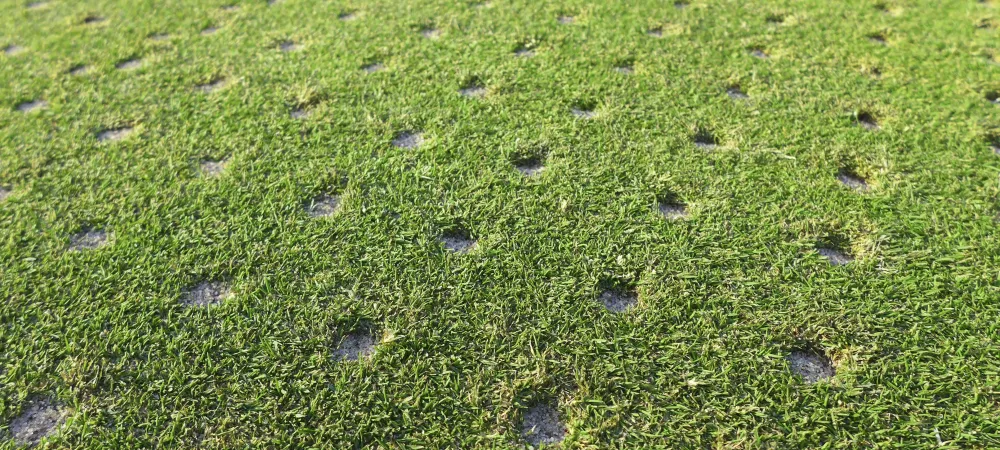Should You Aerate Your Lawn in Ohio?

Keeping your lawn healthy and vibrant takes careful maintenance, and aeration is one key practice that can make a big difference. If you’re a homeowner in Ohio, you might wonder if aerating is worth the time and effort. Here, we’ll break down why aeration can benefit your lawn and what to consider for the unique climate and soil types of Ohio.
What is Lawn Aeration?
Lawn aeration involves perforating the soil with small holes to allow air, water, and nutrients to penetrate the grassroots. This process helps relieve soil compaction, making it easier for the roots to grow deeper and absorb the nutrients they need. Proper aeration creates a thicker, healthier lawn that can better withstand drought, disease, and Ohio’s seasonal changes.
There are three main types of aeration:
- Core Aeration: The most common and effective method, core aeration uses a machine to remove small plugs, or "cores," of soil and thatch from the lawn. This creates space for roots to expand and improves water, nutrient, and oxygen access.
- Spike Aeration: This method uses a solid tine or spike to poke holes in the soil. While it’s less effective than core aeration, it’s a simpler DIY option for small areas with minimal compaction.
- Liquid Aeration: This method involves applying a liquid solution to the lawn, offering a less invasive and often more affordable option for improving soil health, especially in lawns with moderate to light compaction.
Why Aerate Your Lawn in Ohio?
Ohio’s unique climate and soil conditions make lawn aeration an important step in maintaining a healthy yard. Here’s why it’s particularly useful in this region:
- Ohio’s Clay-Heavy Soil
Much of Ohio has clay-heavy soil, which easily compacts over time, especially in high-traffic areas or under heavy rainfall. Compacted soil restricts root growth, preventing your lawn from accessing vital nutrients and moisture. Aeration loosens this compacted soil, allowing water, nutrients, and oxygen to reach deeper into the root zone. - Preparing for Seasonal Changes
Ohio’s climate ranges from hot, humid summers to cold, snowy winters. Aeration in the fall helps prepare the lawn for these temperature extremes. By strengthening the root system, aeration allows your grass to retain moisture better in summer and withstand the harsh winter months. - Thatch Management
Thatch is a layer of dead and living organic material that accumulates between the soil and grass blades. While a small amount of thatch is beneficial, too much can form a barrier, blocking water, air, and nutrients from reaching the roots. Aeration helps break up this thatch, making it easier for your lawn to "breathe." - Enhanced Nutrient Absorption
After aeration, fertilizer and soil amendments can reach the grassroots more easily, improving the effectiveness of these treatments. A well-aerated lawn can absorb nutrients and water up to twice as effectively, making it easier to maintain a vibrant, green landscape.
When is the Best Time to Aerate in Ohio?
Timing is crucial when it comes to aerating your lawn. In Ohio, the optimal time for aeration is during the early fall, when the soil is still warm, and the grass is actively growing. This timing allows the grass to recover quickly and develop strong roots before winter. Aerating in the fall also helps prevent weed seeds from taking over, as they are less active during this period.
If fall isn’t feasible, early spring can be an alternative. However, spring aeration may encourage weed growth and isn’t as effective for building root strength before winter. Spring aeration should be done with caution, especially in lawns with significant weed issues.
How Often Should You Aerate?
The frequency of aeration depends on your soil type and lawn usage:
- High Clay Content Soil: Most Ohio lawns with clay-heavy soil benefit from annual aeration. The dense composition of clay leads to compaction more quickly, especially in areas with high foot traffic or frequent use.
- Sandy Soil: If your lawn has more sandy soil, it may only require aeration every two to three years, as sandy soils are naturally less compacted.
- High-Traffic Lawns: Lawns that experience heavy use from pets, children, or gatherings may need aeration more frequently to relieve compaction.
Is Aeration Really Necessary?
For many Ohio homeowners, aeration is more than just an extra step—it’s a necessity for maintaining a lush, resilient lawn. If your lawn suffers from soil compaction, poor drainage, or heavy foot traffic, aeration can be the key to transforming it into a healthy, thriving landscape.
To learn more about lawn aeration services, contact our team of local experts at Dyna-Green.

